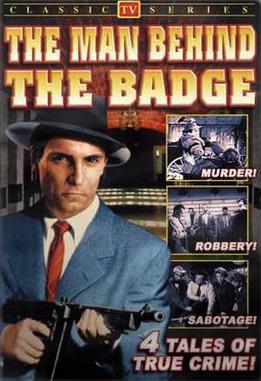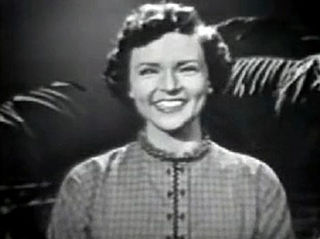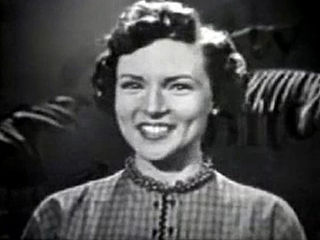
Armstrong Circle Theatre is an American anthology drama television series which ran from June 6, 1950, to June 25, 1957, on NBC, and from October 2, 1957, to August 28, 1963, on CBS. It alternated weekly with The U.S. Steel Hour. It finished in the Nielsen ratings at number 19 for the 1950–51 season and number 24 for 1951–52. The principal sponsor was Armstrong World Industries.
Front Row Center is the title of two American television programs with different formats that were broadcast on different networks.

The Bigelow Theatre is an American anthology series originally broadcast on CBS Television and on the DuMont Television Network.
Kliph Nesteroff is a Canadian author, best known for his 2015 history of American comedy, The Comedians.

Walter Noel Greaza was an American television, radio, stage and film actor.

The Man Behind the Badge is a half-hour American television police drama series which aired on CBS from October 11, 1953, to October 3, 1954, originally hosted by Norman Rose. In its second syndicated season, the host became character actor Charles Bickford. Jerry Robinson was the producer.
Academy Theatre is an American drama anthology television series that aired on NBC from July 25, 1949, to September 12, 1949. It ran for eight weeks as the summer replacement for Chevrolet on Broadway.
The Show Goes On was a variety show that aired in the United States on CBS from January 19, 1950, to January 16, 1952. Robert Q. Lewis was the host. After the debut episode, the program was broadcast on alternate Thursdays at 8 p.m. Eastern Time.
Magnavox Theatre is an American television anthology of comedies and dramas that aired seven hour-long episodes on CBS in 1950, alternating weekly with Ford Theatre. The first episodes were live, with filmed episodes later on. Episode six, according to CBS, was the first hour-long film made in Hollywood specifically for television. The film was made by Hal Roach Studios Inc., which also made "The Hurricane at Pilgrim Hill", which was the seventh and final episode, scheduled for broadcast on December 8, 1950.
Starlight Theatre is a 30-minute American television anthology series of romantic stories that aired on CBS from April 2, 1950, to October 4, 1951. Forty-nine episodes aired. In 1950-1951 it alternated with The George Burns and Gracie Allen Show.
Medallion Theatre, aka Chrysler Medallion Theatre, is a 30-minute American anthology series that aired on CBS from July 11, 1953, to April 3, 1954. Henry Fonda, Claude Rains, and Janet Gaynor made their major television dramatic debuts on this series in various 1953 episodes. Others guest stars included Helen Hayes, Charlton Heston, Ronald Reagan, Jack Lemmon, Rod Steiger, and Roddy McDowell. Among its writers were Rod Serling and Robert Anderson. Directors included Ralph Nelson, Don Medford, Robert Stevens, and Seymour Robbie. The original producer was William Spier.

Hollywood on Television is a five-and-a-half-hour, six-day-a-week live television talk show that starred newcomer Betty White and radio disc jockey Al Jarvis that ran from 1949-1953. When Jarvis left the show in 1951, film star Eddie Albert took his place and co-hosted with White for six months until thirty-three and a half hours of live ad-lib television per week, featuring just the two of them, took its toll and he also resigned. White was then hosting the show alone and is believed to have been the first female television talk show host as a result. After a period of White talking directly into the camera lens for hours at a stretch, the show began accepting guests to interact with her as well as gradually incorporating scripts and sketches.
"The Big Sleep" is a 1950 American TV play based on the novel by Raymond Chandler. It was an episode of the anthology series Robert Montgomery Presents. Montgomery had played Philip Marlowe previously in Lady in the Lake. Many episodes of the series were adaptations of Hollywood films.

The Betty White Show is a television series that aired on KLAC-TV in 1952 and 1953, and on NBC in 1954. The show was a daytime talk show that also featured entertainment segments that are typical of variety shows. Betty White served as both host and producer.
Hollywood Opening Night is an American anthology television program that was broadcast on CBS in 1951-1952 and on NBC in 1952-1953. The NBC version was the first dramatic anthology presented live from the West Coast. Episodes were 30 minutes long.
Dagmar's Canteen was an American variety television series that was broadcast on NBC, first as a single 45-minute episode on November 30, 1951, then as a series of 15-minute episodes from March 22, 1952, until June 14, 1952.
The RCA Victor Show is a 1950s American television program broadcast on NBC that eventually became The Dennis Day Show. It began on November 23, 1951, and ended on August 2, 1954.
American Inventory was a thirty-minute weekly filmed educational series that first aired as a summer replacement Sunday nights during 1951 on NBC. It was funded by the Alfred P. Sloan Foundation with NBC donating the broadcast time and facilities. The series incorporated panel discussions, lectures from experts, film of activities and events taking place out of the studio, and occasional in-studio dramatic scenes. It was an ambitious project, the first educational series produced and broadcast by a network.
The Peter Lind Hayes Show is the title of two American television shows and one American radio program. One TV show was a situation comedy broadcast in prime time on NBC in 1950-1951. The other was a daytime variety program on ABC in 1958-1959. The radio program was a weekly variety show on CBS in 1954-1955.
Big Town is an American television dramatic series that was broadcast beginning on October 5, 1950, and ending on October 2, 1956. It began on CBS and moved to NBC in 1954.






